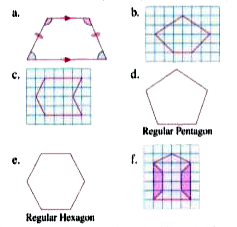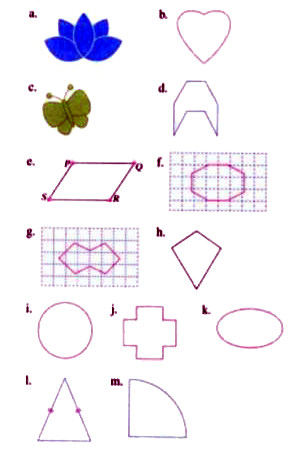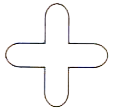Discuss the rotational and line symmetry of the following figure.
To discuss the rotational and line symmetry of the given figures (equilateral triangle, isosceles triangle, and scalene triangle), we will analyze each triangle step by step.
Step 1: Analyze the Equilateral Triangle
1. Line Symmetry: An equilateral triangle has three equal sides and three equal angles. The lines of symmetry can be drawn from each vertex to the midpoint of the opposite side. Therefore, the equilateral triangle has 3 lines of symmetry.
2. Rotational Symmetry: Rotational symmetry means that if we rotate the triangle around its center, it looks the same at certain angles. For an equilateral triangle, if we rotate it by 120 degrees (or 240 degrees), it will look the same. Thus, the order of rotational symmetry is 3 (since it can be rotated at 120 degrees, 240 degrees, and 360 degrees).
Step 2: Analyze the Isosceles Triangle
1. Line Symmetry: An isosceles triangle has two equal sides and one unequal side. There is one line of symmetry that can be drawn from the vertex angle to the midpoint of the base. Therefore, the isosceles triangle has 1 line of symmetry.
2. Rotational Symmetry: For an isosceles triangle, if we rotate it by 360 degrees, it will look the same, but it does not have any other angles where it looks the same. Thus, the order of rotational symmetry is 1.
Step 3: Analyze the Scalene Triangle
1. Line Symmetry: A scalene triangle has all sides and angles different. There are no lines that can divide the triangle into two identical halves. Therefore, the scalene triangle has 0 lines of symmetry.
2. Rotational Symmetry: A scalene triangle does not look the same when rotated at any angle other than 360 degrees. Thus, it has 0 rotational symmetry.
Summary of Findings
- Equilateral Triangle:
- Line Symmetry: 3
- Rotational Symmetry: 3
- Isosceles Triangle:
- Line Symmetry: 1
- Rotational Symmetry: 1
- Scalene Triangle:
- Line Symmetry: 0
- Rotational Symmetry: 0
1. Line Symmetry: An equilateral triangle has three equal sides and three equal angles. The lines of symmetry can be drawn from each vertex to the midpoint of the opposite side. Therefore, the equilateral triangle has 3 lines of symmetry.
2. Rotational Symmetry: Rotational symmetry means that if we rotate the triangle around its center, it looks the same at certain angles. For an equilateral triangle, if we rotate it by 120 degrees (or 240 degrees), it will look the same. Thus, the order of rotational symmetry is 3 (since it can be rotated at 120 degrees, 240 degrees, and 360 degrees).
1. Line Symmetry: An isosceles triangle has two equal sides and one unequal side. There is one line of symmetry that can be drawn from the vertex angle to the midpoint of the base. Therefore, the isosceles triangle has 1 line of symmetry.
2. Rotational Symmetry: For an isosceles triangle, if we rotate it by 360 degrees, it will look the same, but it does not have any other angles where it looks the same. Thus, the order of rotational symmetry is 1.
1. Line Symmetry: A scalene triangle has all sides and angles different. There are no lines that can divide the triangle into two identical halves. Therefore, the scalene triangle has 0 lines of symmetry.
2. Rotational Symmetry: A scalene triangle does not look the same when rotated at any angle other than 360 degrees. Thus, it has 0 rotational symmetry.
- Equilateral Triangle:
- Line Symmetry: 3
- Rotational Symmetry: 3
- Isosceles Triangle:
- Line Symmetry: 1
- Rotational Symmetry: 1
- Scalene Triangle:
- Line Symmetry: 0
- Rotational Symmetry: 0
Topper's Solved these Questions
Similar Questions
Discuss the rotational and line symmetry of a circle.
View SolutionDiscuss the rotational and line symmetry of a rectangle.
View SolutionDraw the lines of symmetry of the following figures.
 .
.
View SolutionDraw the lines of symmetry for the following figures.
 .
.
View SolutionDiscuss the rotational symmetry and line symmetry of an equilateral triangle.
View SolutionDraw the lines of symmetry for the following shapes:
 .
.
View SolutionDiscuss the rotational symmetry of a parallelogram. Also, find the centre of rotation, if any.
View SolutionDraw all possible lines of symmetry in each of the following figures and state the number of lines of symmetry in each case.

View SolutionDraw all possible lines of symmetry in each of the following figures and state the number of lines of symmetry in each case.

View SolutionDraw all possible lines of symmetry in each of the following figures and state the number of lines of symmetry in each case.

View Solution
